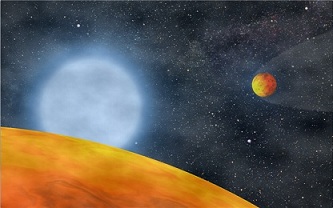 Researchers from the Université de Toulouse and the Université de Montréal detected two Earth-size planets orbiting an old star which just entered the red giant phase. This planetary system is located near the Cygnus and Lyra constellation. The discovery, which results will be published in the prestigious journal Nature, should shed light on the evolution of planetary systems. Researchers from the Université de Toulouse and the Université de Montréal detected two Earth-size planets orbiting an old star which just entered the red giant phase. This planetary system is located near the Cygnus and Lyra constellation. The discovery, which results will be published in the prestigious journal Nature, should shed light on the evolution of planetary systems.
Image: Artistic view of the two planets around their star.
Credits: Université de Toulouse. High resolution images available on demand.
"The two planets, named KOI 55.01 and 55.02, have very small orbits, very close to the host star", explains Gilles Fontaine, professor at the physics department of the Université de Montréal (UdeM) and member of the CRAQ. "In order to be located at such small distances from the host star, the planets probably ended up within the gaseous envelope of the outer layer of the star, and, despite the very high temperature, the planets survived." The host star, KIC 05807616, is the remnant of the core of a red giant exposed by the ejection of the star's outer layers. As the star's size increased, the planets entered the host star, and probably contributed to the mass loss that is necessary for the star to be transformed into a red giant. This leads to believe that planetary systems have an influence on evolution of their host stars. KIC 05807616 was like our Sun (composed mostly of hydrogen) a few billion years ago, but it is now a burning helium core surrounded by a thin hydrogen shell.
The two planets discovered are probably remnants of giant gaseous planets, like Jupiter, orbiting close to their host star at the time it still was burning only hydrogen in its core. They are now chthonian planets, meaning that they became rocky or metallic cores because their gas envelope evaporated during the immersion phase within the host star.
From stellar researcher to planet hunter
Prof. Gilles Fontaine specializes in the study for stars, not planets. By it is by analyzing the pulsations from a star that the presence of two objects around the star was detected. "All stars vibrate and emit pulsations that tell us about their structure and composition. By studying these pulsations, one can identify the presence of a planet orbiting a star", he explained. The analysis of the pulsations of KIC 05807616 observed by the satellite Kepler led the team of researchers (from 8 different countries) to notice intriguing periodic modulations in the signal. Because these cannot be caused by the star, the presence of two celestial bodies orbiting the star KIC 05807616 became the only plausible explanation.
Questioning the current knowledge
The two planets are extremely closed to their host star, which emits a very hot (27 000 degrees) and intense radiation. The extreme temperature on these planets, in particular on the hemisphere facing the star, can be as high as 8000 or 9000 degrees. Such conditions, unheard of among the population of known extra-solar planets, raise many questions about the nature of the celestial bodies capable of surviving these high temperatures. "This is an environment where astrophysicists do not expect the existence of planets, says Professor Fontaine. Our discovery sets several records; these planets are the smallest, the hottest, the closest to the host star, and the fastest that have been observed until now. But the most interesting aspect of this discovery is that, for the first time, we have evidence that planets can have an effect on the evolution of their host star", he concluded.
About this study
The article "A Compact System of Small Planets around an Evolved Post Red Giant Star" is published in the journal Nature, on December 22nd, 2011. The team of researchers was led by Stephane Charpinet (Université de Toulouse), in close collaboration with his former research advisors from the Université de Montréal, Gilles Fontaine and Pierre Brassard. Two other former PhD students of Prof. Fontaine, Suzanna Randall (European Southern Observatory) and Valérie Van Grootel (Université de Liège), also participated in the study. Gilles Fontaine holds a Canada Research Chair in Stellar Astrophysics, and the study was made possible with the support of the FRQNT and the NSERC.
About the CRAQ
The Centre de Recherche en Astrophysique du Québec (CRAQ) is a partnership between the Université de Montréal, McGill University and the Université Laval, gathering the researchers in astronomy and astrophysics from the three institutions. Bishop's University, the Canadian Space Agency, the Cégep de Sherbrooke and private companies (Photon etc., ABB Bomem Inc., Nüvü Caméras) are also collaborators of the CRAQ. The CRAQ is a strategic cluster funded by the Fonds de Recherche du Québec - Nature et Technologie. Finally, the CRAQ is a unique research group of astrophysics researchers, with varied and complementary expertise, favoring innovation, creativity, and offering graduate students a wide variety of fundamental or applied research topics.
|

 Researchers from the Université de Toulouse and the Université de Montréal detected two Earth-size planets orbiting an old star which just entered the red giant phase. This planetary system is located near the Cygnus and Lyra constellation. The discovery, which results will be published in the prestigious journal Nature, should shed light on the evolution of planetary systems.
Researchers from the Université de Toulouse and the Université de Montréal detected two Earth-size planets orbiting an old star which just entered the red giant phase. This planetary system is located near the Cygnus and Lyra constellation. The discovery, which results will be published in the prestigious journal Nature, should shed light on the evolution of planetary systems.